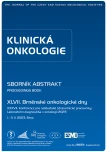Genetic diagnostics of familial hematopoietic disorders
Authors:
Z. Vrzalová 1,2; ; L. Radová 2,3; K. Staňo Kozubík 1,2; J. Štika 2,3; J.- Trizuljak 1 3; Š.- Pospíšilová 1 3; M.- Doubek 1 3
Authors‘ workplace:
Centrum molekulární biologie a genetiky, Interní hematologická a onkologická klinika LF MU a FN Brno
1; Středoevropský technologický institut (CEITEC), MU Brno
2; Ústav lékařské genetiky a genomiky, LF MU Brno
3
Published in:
Klin Onkol 2023; 36(Supplementum 1): 131-136
Category:
Article
doi:
https://doi.org/10.48095/ccko2023S131
Overview
Background: Familial hematopoietic disorders (FHD) are a rare and heterogeneous group of disorders that include hereditary anemias, hereditary thrombocytopenias (inherited thrombocytopenias – IT), congenital neutropenias and congenital bone marrow failure syndromes. FHD is characterized by variable clinical expressivity and incomplete penetrance of the phenotype even within a single family, making it difficult to determine a correct history. The molecular genetic defects of FHD are found in > 300 genes mainly responsible for cellular processes whose functional disorders lead to symptomatic cytopenia, organ dysfunction, tissue damage and syndromes. Some gene variants predispose to the development of severe hematological malignancies or, more rarely, solid tumours. At our institution, we have introduced genetic analysis in families with suspected hereditary hematological diseases. Our focus is unique in the Czech Republic.
Patients and methods: In total, we analyzed 92 families with suspected FHD using modern genomic approaches such as whole-exome sequencing (WES), in silico predictive analysis, multiplex ligation-dependent probe amplification (MLPA) and Sanger sequencing. Results: In 70 families, we detected an already known pathogenic/probably pathogenic variant or a novel variant of unclear clinical significance (VUS), the detection of which led to confirmation or refinement of the diagnosis. Positive findings indicated the occurrence of hereditary thrombocytopenias (TUBB1, ETV6 and ANKRD26 genes – risk of the development of hematological malignancies), Glanzmann thrombasthenia (ITGA2B), anemias, thalassemias, but also the occurrence of rare syndromic diseases in the Czech Republic, e. g. Bernard-Soulier (GP1BA); Heřmanský-Pudlák (HPS1); Wiskott-Aldrich (WAS – increased risk of malignancies); Shwachman-Diamond syndrome (SBDS – a 30% risk of myeloid malignancies) and Sebastian syndrome (MYH9), etc.
Conclusion: Genetic diagnosis has become part of the standard examination of patients with hereditary hematological diseases. It has also helped to clarify many unsolved cases and highlighted the occurrence of rare variants classified as VUS, for which it is necessary to determine their functional impact. Confirming a patient’s diagnosis also has a positive impact on their individualized care and on determining their risk of malignancies or other additional diseases.
Keywords:
genetic analysis – familial hematopoietic disorders – rare variants
Sources
1. Bluteau O, Sebert M, Leblanc T et al. A landscape of germ line mutations in a cohort of inherited bone marrow failure patients. Blood 2018; 131 (7): 717–732. doi: 10.1182/blood-2017-09-806489.
2. Bodine D, Berliner N. Introduction to the review series on “bone marrow failure”. Blood 2014; 124 (18): 2755. doi: 10.1182/blood-2014-08-587394.
3. Collins J, Dokal I. Inherited bone marrow failure syndromes. Hematology 2015; 20 (7): 433–434. doi: 10.1179/1024533215Z.000000000381.
4. Russo R, Andolfo I, Manna F et al. Multi-gene panel testing improves diagnosis and management of patients with hereditary anemias. Am J Hematol 2018; 93 (5): 672–682. doi: 10.1002/ajh.25058.
5. Savoia A. Molecular basis of inherited thrombocytopenias. Clin Genet 2016; 89 (2): 154–162. doi: 10.1111/cge.12607.
6. Noris P, Pecci A. Hereditary thrombocytopenias: a growing list of disorders. Hematology Am Soc Hematol Educ Program 2017; 1: 385-399. doi: 10.1182/asheducation-2017.1.385.
7. Vandenberghe P, Beel K. Severe congenital neutropenia, a genetically heterogeneous disease group with an increased risk of AML/MDS. Pediatr Rep 2011; 22; 3 (Suppl 2): e9. doi: 10.4081/pr.2011.s2.e9.
8. Salavoura K, Kolialexi A, Tsangaris G et al. Development of cancer in patients with primary immunodeficiencies. Anticancer Res 2008; 28 (2B): 1263–1269.
9. Stenson PD, Mort M, Ball EV et al. The Human Gene Mutation Database: towards a comprehensive repository of inherited mutation data for medical research, genetic diagnosis and next-generation sequencing studies. Hum Genet 2017; 136 (6): 665–677. doi: 10.1007/s00439-017-1779-6.
10. Richards S et al. Standards and guidelines for the interpretation of sequence variants: a joint consensus recommendation of the American College of Medical Genetics and Genomics and the Association for Molecular Pathology. Genet Med 2015; 17 (5): 405–424. doi: 10.1038/gim.2015.30.
11. Staňo Kozubík K, Radová L, Pešová M et al. C-terminal RUNX1 mutation in familial platelet disorder with predisposition to myeloid malignancies. Int J Hematol 2018; 108 (6): 652–657. doi: 10.1007/s12185-018-2514-3.
12. Kozubik KS, Radova L, Reblova K et al. Functional analysis of germline ETV6 W380R mutation causing inherited thrombocytopenia and secondary acute lymphoblastic leukemia or essential thrombocythemia. Platelets 2021; 32 (6): 838–841. doi: 10.1080/09537104.2020.1802416.
13. Doubková M, Staňo Kozubík K, Radová L et al. A novel germline mutation of the SFTPA1 gene in familial interstitial pneumonia. Hum Genome Var 2019; 6: 12. doi: 10.1038/s41439-019-0044-z.
14. Noris P, Favier R, Alessi MC et al. ANKRD26-related thrombocytopenia nad myeloid malignancies. Blood 2013; 122 (11): 1987–1989.
15. Doubková M, Trizuljak J, Vrzalová Z et al. Novel genetic variant of HPS1 gene in Hermansky-Pudlak syndrome with fulminant progression of pulmonary fibrosis: a case report. BMC Pulm Med 2019; 19 (1): 178. doi: 10.1186/s12890-019-0941-4.
16. Sýkora M, Vrzalová Z, Vondráková J et al. Dědičná trombocytopenie na podkladě patogenní varianty genu MYH9 diagnostikovaná u dospělé ženy. TAHD 2020; 26 (4): 327–332.
17. Trizuljak J, Staňo Kozubík K, Radová L. et al. A novel germline mutation in GP1BA gene N-terminal domain in monoallelic Bernard-Soulier syndrome. Platelets 2018; 29 (8) : 827–833. doi: 10.1080/ 09537104.2018.1529300.
18. Skalníková M, Staňo Kozubík K, Trizuljak J et al. A GP1BA variant in a Czech family with monoallelic Bernard-Soulier syndrome. Int J Mol Sci 2022; 23 (2) : 885. doi: 10.3390/ ijms23020885.
Labels
Paediatric clinical oncology Surgery Clinical oncologyArticle was published in
Clinical Oncology

2023 Issue Supplementum 1
Most read in this issue
- I. Onkologická prevence a screening
- XIX. Nádory tlustého střeva a konečníku
- X. Nežádoucí účinky protinádorové léčby a podpůrná léčba
- III. Follow-up, sledování onkologických pacientů
